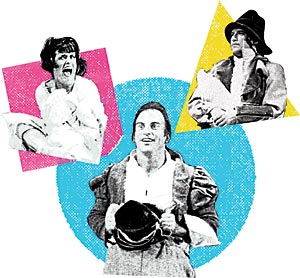 |
|
Clowning around (from left): Performers Molly Brennan, Paul Kalina, and Adrian Danzig |
LATECOMERS, BEWARE. Once, when I arrived at the start of a 500 Clown performance, the troupe stopped mid-introduction to greet me effusively. When another audience member dashed for the bathroom, the actors rearranged the seating. During their popular holiday show, they merrily borrow shoes, scarves, hats, and wallets from their unsuspecting audience-then present the “gifts” to other folks in the crowd.
Despite its name, the most exciting performance troupe in the city right now does not boast 500 clowns. Nor 200, nor 100. There are ruffled shirts and tartan kilts, but no red noses; acrobatics and stage blood but not pies in the face. “Think Buster Keaton, not Bozo,” advises cofounder Adrian Danzig, one of the troupe’s four members, all in their 30s and 40s, all of whom have recently given up other professional endeavors to devote themselves to the ensemble. For six weeks starting June 14th, the troupe stages two of its signature shows, 500 Clown Frankenstein and 500 Clown Macbeth, in repertory at Steppenwolf Theatre. In December, it will début in New York City with a two-week run at the famed arts center P.S. 122, a potential national launching pad.
“It’s a bit of a seize-the-moment mentality,” says Danzig’s wife, Leslie, their director. She’s sitting in the couple’s warm Printers’ Row loft, which is compartmentalized with walls from old barns. “There have been more opportunities than we’ve had time to pursue.” There’s a droll irony in this industriousness, since Frankenstein and Macbeth both turn on the clowns’ inability to perform the classic tales in the titles. The operating table in Frankenstein gives the actors fits, while they spend most of Macbeth clambering on a scaffold, trying to grasp a crown hanging just beyond their reach. (Adrian Danzig, Paul Kalina, and Molly Brennan perform; Leslie Buxbaum Danzig doesn’t appear onstage.)
Imagine the Three Stooges’ slap-around high jinks crossed with Samuel Beckett’s dark comedy of futility, and you’ll get a sense of the unique artistry that’s given the 500 Clown players enough impetus to quit their day jobs. Deceptively simple premises turn into moments of spontaneous theatrical delight as they fall under the set, knock each other around, and roam the audience seeking refuge, expiation, and candy. “We know we start here and end there,
but we don’t know how we get there,” says Brennan. “It all depends on whether someone comes in late . . .”
“. . . does someone have a fantastic laugh,” Danzig adds.
“. . . a great hat, a great face,” Brennan concludes.
The potential for audience members to actually affect the course of the show is a big part of 500 Clown’s appeal. “The audiences are inside the joke, and it’s quite thrilling,” says Martha Lavey, Steppenwolf’s artistic director. “It raises the level of giddiness to think, They’re wild and nuts. Once they transgress the boundary of performer and audience it’s, Oh, no, these clowns might come at me-anything can happen.”
The performers don’t know themselves what will happen onstage-or off. But, having built an entire aesthetic on taking physical and creative risks, they’re applying the same principle to their own careers. “At our shows you’re not sure what the end is,” Danzig says. “That’s the way we’re still operating.”
Illustration: Wes Duvall, Photography: Elliot Lieberman


